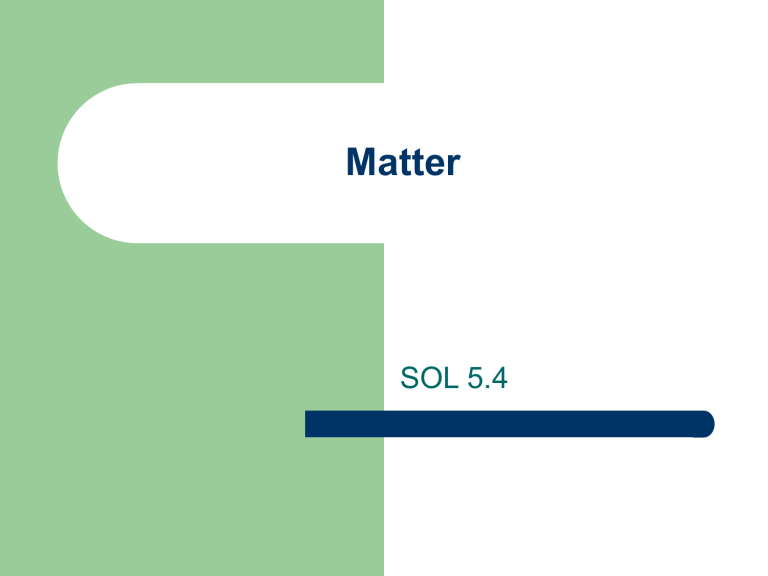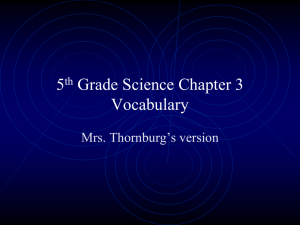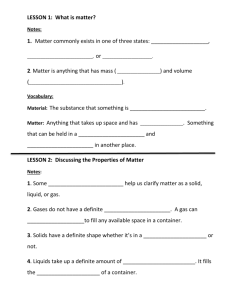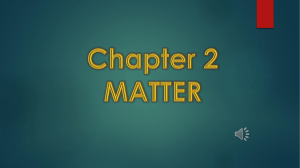Matter Test Review
advertisement

Matter SOL 5.4 Matter is… Matter is… …anything that has MASS and VOLUME (takes up space) An element is… An element is… …matter made up of one kind of atom. A compound is… A compound is… …2 or more elements chemically combining to form a new substance. A simple mixture is… A simple mixture is… …2 or more substances mixed together. It can be separated by hand or filter. A solution is… A solution is… …where one substance dissolves in a liquid. It can be separated by evaporation. An atom is… An atom is… …the smallest particle of matter. Match the parts of an atom… Nucleus a. Positive part of the atom – located in the nucleus Protons b. Negative part of the atom – located outside of the nucleus Neutrons c. Center of the atom Electrons d. Neutral part of the atom – located in the nucleus Parts of an atom… Nucleus a. Positive part of the atom – located in the nucleus Protons b. Negative part of the atom – located outside of the nucleus Neutrons c. Center of the atom Electrons d. Neutral part of the atom – located in the nucleus Parts of an atom… Nucleus a. Positive part of the atom – located in the nucleus Protons b. Negative part of the atom – located outside of the nucleus Neutrons c. Center of the atom Electrons d. Neutral part of the atom – located in the nucleus Parts of an atom… Nucleus a. Positive part of the atom – located in the nucleus Protons b. Negative part of the atom – located outside of the nucleus Neutrons c. Center of the atom Electrons d. Neutral part of the atom – located in the nucleus Parts of an atom… Nucleus a. Positive part of the atom – located in the nucleus Protons b. Negative part of the atom – located outside of the nucleus Neutrons c. Center of the atom Electrons d. Neutral part of the atom – located in the nucleus MASS We measure mass using a ______________. Mass is measured in _________. MASS We measure mass using a balance scale. Mass is measured in _________. MASS We measure mass using a balance scale. Mass is measured in grams. VOLUME We measure volume of a liquid using a ______________. Volume of a liquid is measured in _________. VOLUME We measure volume of a liquid using a graduated cylinder. Volume of a liquid is measured in _________. VOLUME We measure volume of a liquid using a graduated cylinder. Volume of a liquid is measured in milliliters. Elements All elements have a symbol of one or two letters. If it is one letter, then it is a capital letter. If it is two letters, then the first is capital and the second if lowercase. What is the element’s symbol? Carbon What is the element’s symbol? Carbon C What is the element’s symbol? Carbon Oxygen C What is the element’s symbol? Carbon C Oxygen O What is the element’s symbol? Carbon C Oxygen O Gold What is the element’s symbol? Carbon C Oxygen O Gold Au What is the element’s symbol? Carbon C Oxygen O Gold Au Neon What is the element’s symbol? Carbon C Oxygen O Gold Au Neon Ne Compounds All compounds have a chemical formula. It contains the element symbols (of the elements that make it up) and numbers (subscripts) to show how many of each element. What compound is it? H2O What compound is it? H2O water What compound is it? H2O CO water What compound is it? H2O water CO carbon monoxide What compound is it? H2O water CO carbon monoxide CO2 What compound is it? H2O water CO carbon monoxide CO2 carbon dioxide What compound is it? H2O water CO carbon monoxide CO2 carbon dioxide Simple Mixture or Solution Tea Lemonade Chex Mix Salad Coffee Fruit Salad Trail Mix Toy box Salt Water Soda Simple Mixture or Solution Tea - solution Lemonade Chex Mix Salad Coffee Fruit Salad Trail Mix Toy box Salt Water Soda Simple Mixture or Solution Tea - solution Lemonade - solution Chex Mix Salad Coffee Fruit Salad Trail Mix Toy box Salt Water Soda Simple Mixture or Solution Tea - solution Lemonade - solution Chex Mix – simple mixture Salad Coffee Fruit Salad Trail Mix Toy box Salt Water Soda Simple Mixture or Solution Tea - solution Lemonade - solution Chex Mix – simple mixture Salad – simple mixture Coffee Fruit Salad Trail Mix Toy box Salt Water Soda Simple Mixture or Solution Tea - solution Lemonade - solution Chex Mix – simple mixture Salad – simple mixture Coffee - solution Fruit Salad Trail Mix Toy box Salt Water Soda Simple Mixture or Solution Tea - solution Lemonade - solution Chex Mix – simple mixture Salad – simple mixture Coffee - solution Fruit Salad – simple mixture Trail Mix Toy box Salt Water Soda Simple Mixture or Solution Tea - solution Lemonade - solution Chex Mix – simple mixture Salad – simple mixture Coffee - solution Fruit Salad – simple mixture Trail Mix – simple mixture Toy box Salt Water Soda Simple Mixture or Solution Tea - solution Lemonade - solution Chex Mix – simple mixture Salad – simple mixture Coffee - solution Fruit Salad – simple mixture Trail Mix – simple mixture Toy box – simple mixture Salt Water Soda Simple Mixture or Solution Tea - solution Lemonade - solution Chex Mix – simple mixture Salad – simple mixture Coffee - solution Fruit Salad – simple mixture Trail Mix – simple mixture Toy box – simple mixture Salt Water - solution Soda Simple Mixture or Solution Tea - solution Lemonade - solution Chex Mix – simple mixture Salad – simple mixture Coffee - solution Fruit Salad – simple mixture Trail Mix – simple mixture Toy box – simple mixture Salt Water - solution Soda - solution Solids, Liquids, and Gases Solids have a definite _____ and _____. Particles are packed _____ and they _____ to move. Solids, Liquids, and Gases Solids have a definite shape and _____. Particles are packed _____ and they _____ to move. Solids, Liquids, and Gases Solids have a definite shape and volume. Particles are packed _____ and they _____ to move. Solids, Liquids, and Gases Solids have a definite shape and volume. Particles are packed close together and they _____ to move. Solids, Liquids, and Gases Solids have a definite shape and volume. Particles are packed close together and they vibrate to move. Solids, Liquids, and Gases Liquids have a definite _____, but do not have a definite _____. Particles are _____ than a solid, and they move ______ than a solid. Solids, Liquids, and Gases Liquids have a definite volume, but do not have a definite _____. Particles are _____ than a solid, and they move ______ than a solid. Solids, Liquids, and Gases Liquids have a definite volume, but do not have a definite shape. Particles are _____ than a solid, and they move ______ than a solid. Solids, Liquids, and Gases Liquids have a definite volume, but do not have a definite shape. Particles are farther apart than a solid, and they move ______ than a solid. Solids, Liquids, and Gases Liquids have a definite volume, but do not have a definite shape. Particles are farther apart than a solid, and they move faster than a solid. Solids, Liquids, and Gases Gases do not have a definite _____ or _____. Particles are spread ______ and move ______ and _____. Solids, Liquids, and Gases Gases do not have a definite shape or _____. Particles are spread ______ and move ______ and _____. Solids, Liquids, and Gases Gases do not have a definite shape or volume. Particles are spread _____ and move ______ and _____. Solids, Liquids, and Gases Gases do not have a definite shape or volume. Particles are spread far apart and move ______ and _____. Solids, Liquids, and Gases Gases do not have a definite shape or volume. Particles are spread far apart and move freely and _____. Solids, Liquids, and Gases Gases do not have a definite shape or volume. Particles are spread far apart and move freely and quickly. Changes in Phases of Matter Evaporation a) change from solid to liquid Melting b) change from gas to liquid Freezing c) change from liquid to gas Condensation d) change from liquid to solid Changes in Phases of Matter Evaporation a) change from solid to liquid Melting b) change from gas to liquid Freezing c) change from liquid to gas Condensation d) change from liquid to solid Changes in Phases of Matter Evaporation a) change from solid to liquid Melting b) change from gas to liquid Freezing c) change from liquid to gas Condensation d) change from liquid to solid Changes in Phases of Matter Evaporation a) change from solid to liquid Melting b) change from gas to liquid Freezing c) change from liquid to gas Condensation d) change from liquid to solid Changes in Phases of Matter Evaporation a) change from solid to liquid Melting b) change from gas to liquid Freezing c) change from liquid to gas Condensation d) change from liquid to solid







